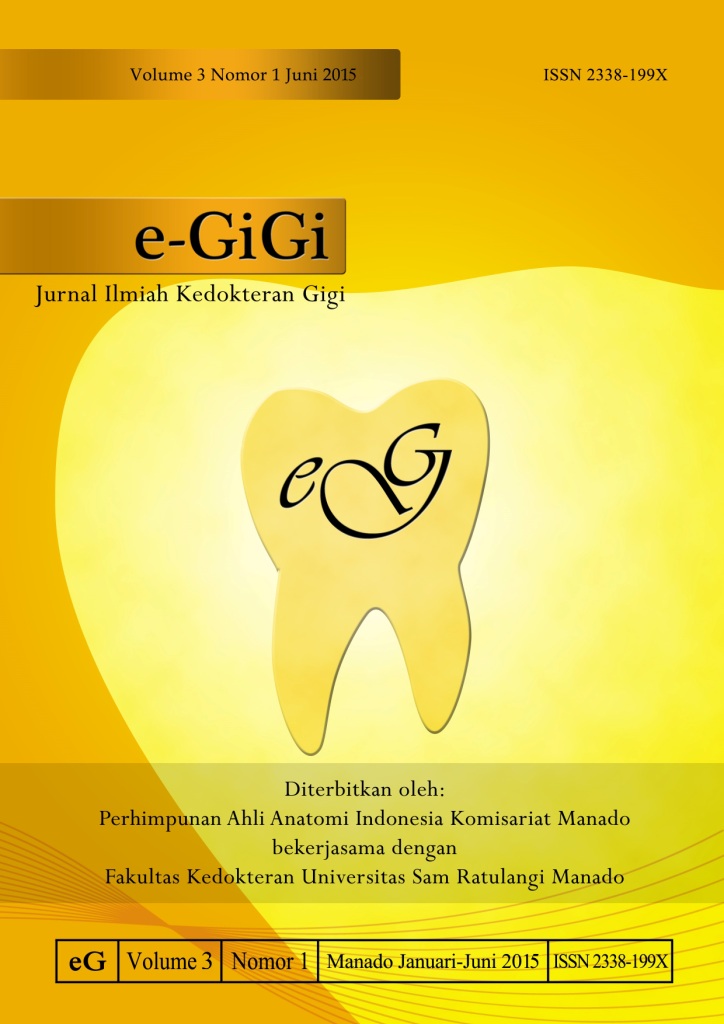UJI DAYA HAMBAT EKSTRAK RUMPUT LAUT GRACILARIA SP TERHADAP PERTUMBUHAN BAKTERI STAPHYLOCOCCUS AUREUS
DOI:
https://doi.org/10.35790/eg.3.1.2015.6600Abstract
Abstract: Infection usually caused by microorganism such as bacterial. One example of infection is abscess which caused by Staphylococcus aureus. Staphylococcus aureus is a pathogenic bacterial in mouth. Seaweed is a part of sea plants. Nowadays, seaweed has been used as material of agar-agar, alginate, and even medicine. Indonesia has good potential to develop and use its richness at the sea. One of species that has been cultivated is Gracilaria verrucosa or known with local name “bulung rambu†(Bali) or “sango-sango†(Sulawesi). The characteristics of Gracilaria verrucosa is thallus silindris, slick, and has yellowish-brown or yellowish-green. Green, red, or brown seaweed is a potential source of bioactive compound that useful for pharmacy industry improvement like antibacterial, antivirus, antifungal, and cytostatic. This study purpose was to find out if seaweed extract (Gracilaria sp.) can inhibit growth of Staphylococcus aureus. This study was an experimental laboratory with true experimental design and posttest only control design. study subject are seaweed extract Gracilaria sp. that dissolved with 95% ethanol which evaporated in oven. Inhibition zone of Gracilaria sp. extract evaporated in the oven at each repeated were 2.5mm, 3.5mm, 3mm. Inhibition zone created from Gracilaria sp. extract that evaporated with vacuum rotary evaporator in each repeated were 2mm, 2mm, and 2.5mm. Study results showed that seaweed extract (Gracilaria sp.) didn’t have exhibition zone against Staphylococcus aureus.
Keywords: inhibition test, seaweed (gracilaria sp), staphylococcus aureus.
Abstrak: Penyakit infeksi yang biasanya disebabkan oleh mikroorganisme yaitu bakteri. Salah satu contoh penyakit infeksi tersebut yaitu abses yang disebabkan oleh bakteri Staphylococcus aureus. Staphylococcus aureus adalah patogen utama dalam rongga mulut. Rumput laut merupakan bagian dari tumbuhan laut perairan. Saat ini rumput laut telah dimanfaatkan sebagai bahan baku industri agar-agar, dan alginat bahkan obat-obatan. Indonesia mempunyai potensi yang baik untuk mengembangkan dan memanfaatkan kekayaan lautnya. Salah satu jenis yang sudah banyak dibudidayakan adalah Gracilaria verrucosa atau dikenal dengan nama daerah bulung rambu (bali) atau sango-sango (sulawesi). Ciri-ciri dari Gracilaria verrucosa, yaitu thallus silindris, licin, dan berwarna kuning-coklat atau kuning-hijau.Rumput laut hijau, merah ataupun coklat merupakan sumber potensial senyawa bioaktif yang sangat bermanfaat bagi pengembangan industri farmasi seperti sebagai antibakteri, antivirus, antijamur dan sitotastik. Penelitian ini bertujuan untuk mengetahui apakah ekstrak rumput laut (Gracilaria sp.) dapat menghambat pertumbuhan bakteri Staphylococcus aureus. Penelitian ini merupakan penelitian eksperimental laboratorium, menggunakan rancangan eksperimental murni (true experimental design) dengan rancangan penelitian posttest only control design. Subjek dari penelitian ini ialah ekstrak rumput laut Gracilaria sp. yang dilarutkan dengan etanol 95% yang dievaporasi menggunakan rotary vacuum evaporator dan dipanaskan dalam oven. zona hambat dari ekstrak Gracilaria sp. yang dievaporasi dengan oven pada masing-masing pengulangan ialah 2,5 mm, 3,5 mm, 3 mm. Demikian juga zona hambat yang terbentuk dari ekstrak Gracilaria sp. yang dievaporasi dengan vacuum rotary evaporator pada masing-masing pengulangan ialah 2 mm, 2 mm, dan 2,5 mm. Hasil penelitian menunjukkan bahwa ekstrak rumput laut (Gracilaria sp.) tidak memiliki daya hambat terhadap bakteri Staphylococcus aureus.
Kata kunci: uji daya hambat, rumput laut (gracilaria sp.), staphylococcus aureus.
Downloads
Published
How to Cite
Issue
Section
License
COPYRIGHT
Authors who publish with this journal agree to the following terms:
Authors hold their copyright and grant this journal the privilege of first publication, with the work simultaneously licensed under a Creative Commons Attribution License that permits others to impart the work with an acknowledgment of the work's origin and initial publication by this journal.
Authors can enter into separate or additional contractual arrangements for the non-exclusive distribution of the journal's published version of the work (for example, post it to an institutional repository or publish it in a book), with an acknowledgment of its underlying publication in this journal.
Authors are permitted and encouraged to post their work online (for example, in institutional repositories or on their website) as it can lead to productive exchanges, as well as earlier and greater citation of the published work (See The Effect of Open Access).






